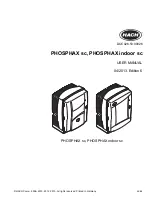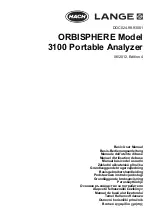
SDA Operator’s Manual
SDA-OM-E Rev H
345
Edge-Edge Jitter Measurement Controls
Adjust Rj
The TIE measurements in the edge-to-edge mode are measured by determining the timing
between transitions of the data signal and comparing this to the nominal UI. The measurement is
essentially the difference between two random values (the location of each transition in time). The
random part of this TIE measurement (random jitter) is the sum of the random jitter values from
each of the two edges and, as a result, is larger by a factor of the square root of 2 compared to
the actual TIE (measured relative to a reference). The
Adjust Rj
control divides the measured
edge-edge Rj by the square root of 2 to convert it to the equivalent edge-reference value. At the
same time, the total jitter is recomputed when this control is selected by multiplying the adjusted
Rj by the appropriate number of standard deviations determined by the selected BER (14 for 10e-
12 BER). The result is that Tj and Rj more closely approximate the edge-reference
measurements when the
Adjust Rj
control is checked.
Async N Cycle Plot
In the absence of a reference clock, periodic jitter cannot be directly measured from the data
record because there is no timing reference on which to base the Fourier transform. The SDA
employs a function called the Alternate N Cycle plot to measure periodic jitter on edge-to-edge
TIE values. The plot displays the standard deviation of a histogram of the timing variations for
transitions in the data signal that are spaced
n
UI apart. Each Y-value in this plot represents the
standard deviation of the histogram for a given value of
n
as
n
varies from 1 to the maximum
value set in the
Max N
field, the upper limit of which is determined by the number of UIs in the
analyzed signal. The
HPF Corner Freq.
readout displays the minimum frequency jitter
component that can be measured.
Edge-Edge Spacing Controls
The histogram and bathtub curve of TIE measurements are derived by determining the time
interval between transitions of the data signal. The timing is measured between adjacent edges
that are not always 1 UI apart, depending upon the data pattern. The
For Edge-Edge Use All
Edges
checkbox, when checked, includes all adjacent transitions in its measurement. When this
control is un-checked, only transitions that are the selected number of UI apart are measured. In
this case, the measurement compares transitions 1 with N, 2 with N+2, 3 with N+3, etc. The
Use
only UI spacing
control sets the UI spacing to be used in the jitter measurement.
Содержание SDA
Страница 1: ...SERIAL DATA ANALYZER OPERATOR S MANUAL December 2007 ...
Страница 148: ...Standard Horizontal Parameter Help Markers Standard Vertical Parameter Help Markers 148 SDA OM E Rev H ...
Страница 223: ...SDA Operator s Manual Example 6 SDA OM E Rev H 223 ...
Страница 225: ...SDA Operator s Manual SDA OM E Rev H 225 ...
Страница 232: ...In this figure the panel has been pasted onto the Excel sheet for comparison 232 SDA OM E Rev H ...
Страница 243: ...SDA Operator s Manual This example used the CORREL Array1 Array2 function of Excel as depicted below SDA OM E Rev H 243 ...
Страница 246: ...246 SDA OM E Rev H ...
Страница 247: ...SDA Operator s Manual Excel Example 5 Using a Surface Plot SDA OM E Rev H 247 ...
Страница 279: ...SDA Operator s Manual Convolving two signals SDA OM E Rev H 279 ...
Страница 310: ...The jitter wizard is accessed from the Analysis drop down menu 310 SDA OM E Rev H ...
Страница 327: ...SDA Operator s Manual SDA OM E Rev H 327 ...
Страница 328: ...328 SDA OM E Rev H ...
Страница 394: ...394 SDA OM E Rev H ...
Страница 395: ...SDA Operator s Manual SDA OM E Rev H 395 ...
















































